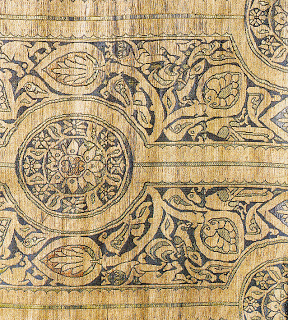I distinctly remember having a handful of ideas for blog posts a few days ago - while in South Tyrol, and of course I did not take notes of these ideas.
Then I was back, and immersing myself in all the reading and all the other stuff that hopped around in my brain crying for attention, and gone they were, the little inspiration particles.
So instead of writing you some nice original content that might even have something to do with medieval textiles, I am re-posting you a heads-up that came from the Quilt History List over to another list (that at least has something to do with medieval textiles):
If you are not able to just swish over to London or if you don't even know what the Tristan Quilt is, you can have a look at some pictures here on the V&A website. Enjoy!
Then I was back, and immersing myself in all the reading and all the other stuff that hopped around in my brain crying for attention, and gone they were, the little inspiration particles.
So instead of writing you some nice original content that might even have something to do with medieval textiles, I am re-posting you a heads-up that came from the Quilt History List over to another list (that at least has something to do with medieval textiles):
From the Quilt History List:
Dear friends of textile history:
The year 2010 is extraordinary for those interested in early quilt history. Not only is the Victoria and Albert Museum's Tristan Quilt now on public view in London for the first time in generations, but the sister quilt in the collection of the National Museum of Bargello and known there as the Coperta di Usella, will go on public display at the Museo Palazzo Davanzati, Florence, from April 24 to June 24, 2010 under the auspices of the Italian Ministry for Cultural Activities. These two quilts are known as rare surviving examples of all white figurative quilting attributed to a Sicilian atelier circa 1360-1400 (1). As such, they are key pieces in understanding the tradition of quilting from the Middle Ages to present day.
If you are not able to just swish over to London or if you don't even know what the Tristan Quilt is, you can have a look at some pictures here on the V&A website. Enjoy!









